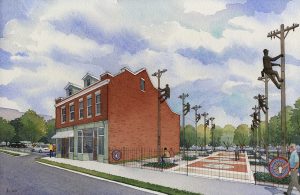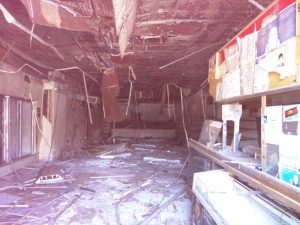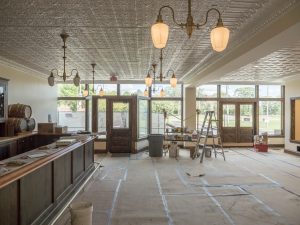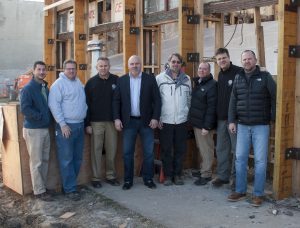
Grand opening coincides with IBEW’s 125th anniversary and 39th annual International Convention
As a gift to launch our 125th Anniversary, the officers and members of IBEW Local 1 are proud to present the renovated birthplace of our great union as a lasting memorial to our founders and a permanent tribute to the future of our industry and our members across this great nation.
The modest boarding house where Henry Miller founded the National Brotherhood of Electrical Workers (NBEW) 125 years ago in St. Louis has been transformed into a museum, creating a lasting testament to the rich history of the union, now known as the International Brotherhood of Electrical Workers (IBEW).
“We hope that all IBEW members will be inspired by the house and the history it holds, and see it as a home for everyone in the Brotherhood,” said IBEW Local 1 Business Manager Frank Jacobs. “We’ve come a long way since Miller and the other founders started this union, and it’s important that we don’t forget that. We need to know where we came from.”
The Henry Miller Museum opens its doors for the first time Thursday, Sept. 15, 2016. The timing of the grand opening coincides with the IBEW’s 125th anniversary and the International Union’s 39th annual convention, which is being held in St. Louis Sept. 19 – 23.
Construction on the $6 million project began late last year. The former brick boarding house, located at 2728 Dr. Martin Luther King Drive (formerly Franklin Avenue) in the JeffVanderLou neighborhood, has been turned into the museum and an adjacent lot features a Founders’ Park with 10 utility poles, each with a statue of a lineman to represent the 10 founding fathers.
ABOUT HENRY MILLER
Miller dedicated his life to organizing electrical workers. After speaking with other workers at an expo in St. Louis in 1890, he saw a pattern of long and dangerous days for meager pay, with little training.

A union was the clear answer. With help from the American Federation of Labor, Miller and others came together and formed the first St. Louis Electricians’ Union, Local 5221 of the AFL.
But Miller knew that true bargaining power could only come from a national union. So he set out to make it happen. In 1891, in the unassuming boarding house he called home, the first convention was held with 10 delegates in attendance. It was here that the NBEW was born, and Miller was elected as the first president.
Everywhere he went, Miller talked about the benefits of organizing a union. In his first year as president, locals were chartered in more than 10 major cities. His tenacity and courage were recognized by many of the people he encountered, including fellow officer J.T. Kelly, the union’s first secretary-treasurer. “No man could have done more for our union in its first years than he did,” Kelly said.
THE QUEST TO PURCHASE THE BUILDING
In 2009, the IBEW International Office released a six-minute video on the union’s origins, which included the story of Miller and the Brotherhood’s early days in St. Louis. It also discussed the role of the boarding house, and perhaps more importantly for Local 1, that it was still standing just six miles from the flagship union’s current office location.
Realizing that this structure was one of very few tangible items left from the Brotherhood’s birth, a small group of Local 1 leaders – including Jacobs, Treasurer Dave Roth and Recording Secretary John Kahrhoff – set out to bring the building home. The three first seriously considered buying and restoring the historic building during a summer 2014 meeting to discuss the upcoming IBEW convention in St. Louis.

“When we first saw the place, we knew in our hearts we had to save it,” Jacobs said. “And we wanted to do something special as the hosts of this convention. We didn’t know how we’d do it or how we’d pay for it, but once this group of us sat down and started thinking about buying the place, it started to get real.”
Within months and with generous donations from 11 other locals from around the country, Local 1 was able to purchase the property for $53,680. Meanwhile, Local 1’s Director of Government Affairs Tim Green secured the land on either side of the building for parking lots and the Founders’ Park.
“A lot of work went into getting us to that point,” Kahrhoff said, recalling the effort. “But I don’t think any of us realized just how much of a passion project this would be.”

RECREATING THE PAST
The treacherous task of venturing inside the run-down building fell to Roth, who volunteered to inspect the second story, which had been boarded up since the 1950s.
“That was probably the most gratifying part of this whole project to me, to be able to get in there and to stand on the floor where Henry Miller and those 10 founding fathers stood … it was breathtaking,” Roth said.
Roth’s older brother, Dale, a 37-year Local 1 wireman at Sachs Electric, was hired as superintendent to run the job site. “Dale became a part of our team, and he’s done such a phenomenal job,” Kahrhoff said.
Work started on Oct. 17, 2015 and just 11 months later, it’s a whole new building. “We surgically demolished everything inside the four original walls,” said Dale Roth, who considers the project the capstone on his career. “We saved the floor from Henry Miller’s bedroom, and everything else that was salvageable – but this is a new, modern building inside that original shell.”
BUILT WITH UNION HANDS
Dozens of IBEW members from Local 1 and St. Louis Local 1439 worked on the house, and other trades, from bricklayers and laborers to operating engineers and plumbers were on site throughout. “We took special care to make sure all of the work was done 100-percent union and that every piece we could source was union-built in America,” Roth said.
“Through all of it, we’ve really leaned on one another to drive this thing forward,” Jacobs said. “I just can’t say enough about this group, and they’ve done it all while keeping up their day jobs. Whatever it took to get the job done, these guys have been there every step of the way.”
IN RETROSPECT

With the museum complete, the foursome recently took some time to reflect on the enormity of the challenge they undertook.
“To have been able to do this for our entire Brotherhood, for the millions of men and women who have ever been a part of the IBEW,” Kahrhoff said, “is just the most gratifying feeling in the world. I don’t know how many thousands of hours we’ve put into this, but seeing it nearly finished, it’s been worth every second.”
“I just can’t wait to share this with members from all over North America,” Jacobs said. “So many brothers and sisters have donated to this effort, and we hope they and others will come and visit and learn about their union’s history standing in the room where it all began.”
ELECTRICAL WORKERS HISTORICAL SOCIETY
Shortly after purchasing the building, Local 1 turned the project over to the newly formed Electrical Workers Historical Society, a 501(C)3 tax-exempt organization which is managing and raising the funding to cover the cost of the renovation as well as ongoing maintenance.
The society is governed by a board of directors, including: International President Lonnie R. Stephenson, Secretary-Treasurer Salvatore J. Chilia, 11th District Vice President Curtis E. Henke, Jacobs, and Local 1 Attorney James I. Singer.
“I really don’t know where we would have been without the support of President Stephenson and Secretary-Treasurer Chilia,” Jacobs said. “We’ve done so much of the nuts and bolts of the work here, but their support has been what has made all of this possible.”
For more information about the museum or to donate, visit nbew-ibewmuseum.org.
(Some information for this article was provided courtesy of the IBEW.)

